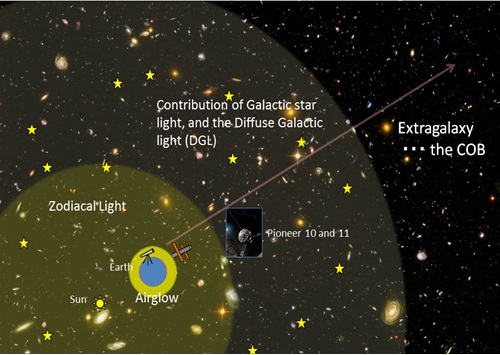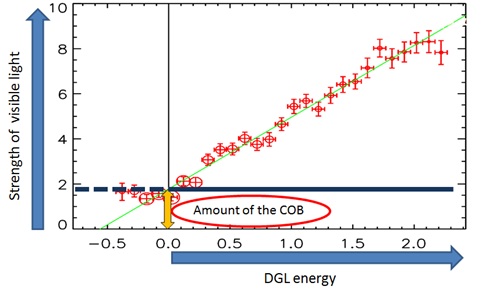The Cosmic Optical Background (COB) is detected for the first time. And the COB is mainly comprised of normal galaxies.
The Cosmic Optical Background (COB), which is the optical component of extragalactic background light, is integrated radiation from all light sources outside the Galaxy. Measuring the amount of the COB light should aid in the understanding of the optical characteristics of unknown substances (e.g., dark matter, which many scientists are researching). Additionally, the COB is the basis for the theory of galaxy formation, and consequently contributes to comprehending the cosmic framework. However, estimating the amount of the COB on/near the Earth is difficult, even if the Hubble Space Telescope is used, because the COB is much fainter than other light components such as the airglow*1 and zodiacal light*2 (Fig. 1). To eliminate the influence of these optical components, light must be observed far from the Sun and Earth to measure the COB.
In order to avoid the above problem, Yoshiki Matsuoka from the Quest for Fundamental Principles in the Universe GCOE program at Nagoya University and his collaborators have determined the COB by using data from Pioneer 10 and 11, which are spacecrafts launched in 1972 and 1973, respectively. However, the observed data is the sum of galactic starlight, the Diffuse Galactic Light (DGL)*3, and the COB (Fig. 1). Therefore, the contributions of other sources must be removed to extract the COB. The research team subtracted the brightness contribution of Galactic stars from the observed light data using all-sky star catalogs, which describe the brightness of each star in the Galaxy. On the other hand, to subtract the "DGL" contribution, the research team focused on the relationship between far-infrared brightness, which represents the DGL, and the observed brightness from the Pioneer data with the Galactic starlight contribution subtracted. Through these efforts, they discovered a linear relation between each dataset (Fig. 2). According to this relationship, if far-infrared brightness (DGL) equals 0 then the corresponding observed brightness from the Pioneer data is the amount of the COB. As a result, they discovered that the COB is equal to the light of three candles spread over Tokyo Disneyland if there is no other light.
Matsuoka and his collaborators not only unveiled the accurate amount of the COB, but were also the first to detect the optical character of an unknown substance. By comparing the detected COB with the integrated light of galaxies, which has been resolved by previous researchers, they found that the COB is mainly comprised of normal galaxies and there are few contributions from other populations such as dark matter. This means that dark matter does not emit in the visible light region.
"Total amount of the cosmic light such as the COB, which could contain the radiation from unknown sources, is crucial information for understanding the galaxy formation and evolution. It is an important constraining condition in the simulation of the evolution of mass distribution in the framework of the standard cosmology.", Matsuoka said. Additionally, he said, "We focused on the visible light in this work, but will try to investigate other wavelength ranges of light where many research problems remain to be solved, in the future."

Fig. 1:The image of observing the COB.

Fig. 2:The relationship between far-infrared brightness, which represents the DGL,
and the observed brightness from the Pioneer data with the Galactic starlight contribution subtracted.
Foot Note
- "Airglow" is produced by light reflecting off atmospheric molecules and light emissions of these molecules.
- "Zodiacal Light" is produced by sunlight reflecting off interplanetary dust particles.
- "Diffuse Galactic light (DGL)" is starlight scattered by interstellar dust.
Affiliated Researchers
The Nagoya University affiliated researchers mentioned in this highlight are from the Quest for Fundamental Principles in the Universe GCOE program.
Reference
1. Y Matsuoka, N Ienaka, K Kawarwa, S Oyabu, "Cosmic Optical Background: the View from Pioneer 10/11", ApJ 736 [2011] 119 | article